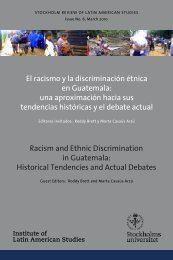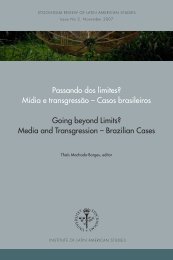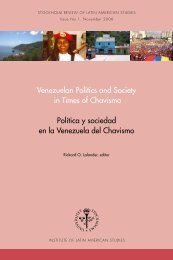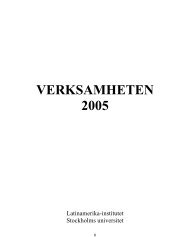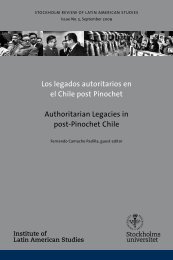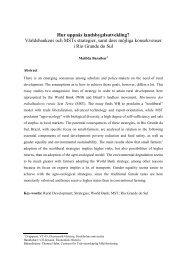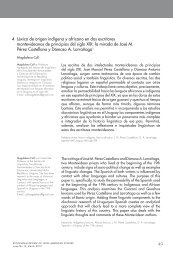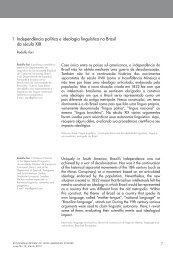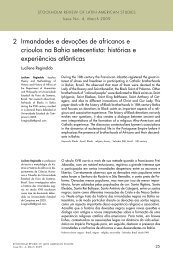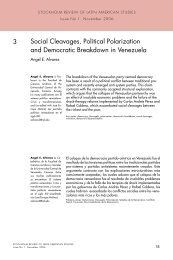“some Brazilians […] do and answer such question. [Therefore] becomes possible to park inforbidden places, jump queues in government departments, receive some kind <strong>of</strong> law benefit orbeing a general rule exception” (Almeida: 16, 2007).Nevertheless the efficiency <strong>of</strong> the “do you know with whom you are talking to?” scam can bepartly explain by the fact that this high given position to the elites in Brazil is supported by themasses to a larger extent than for the ones that can take advantage <strong>of</strong> it- although the elites havetheir own ways to keep its privileges. According to Alberto Almeida in what he called PesquisaNacional Brasileira 4 , about 70% <strong>of</strong> the population that have four years, or less, <strong>of</strong> studies refusesto threat his-her boss as “você” (you) – instead <strong>of</strong> “senhor(a) (sir-madam)- even when asked bytheir employers, or to use the same lift <strong>of</strong> their hirers though when it is “allowed” by theresidential building tenants association 5 .b. THE ‘SEEM TO HAVE’ SOCIETYTherefore, through its effective hierarchical social scheme, one would argue that social statusand wealth are extremely significant in Brazil; thus the postmodern idea that we live on aConsumer Society (Baudrillard, 1998) would fit well over Brazilian frames. However a goodshare <strong>of</strong> the Globalization Social Club discussion comes from the tension between views overwestern society from two <strong>of</strong> most famous postmodernists, Jean Baudrillard and Guy Debord(Debord, 1994): a society where what matters is not solely be, nor just have, but where,sometimes, it is enough to seem to have.c. A ‘GLOBAL ELITE’ EXISTS?Let‟s make a necessary break on Brazilian society discussion for few lines and aim to broaderpicture: the existence, or not, <strong>of</strong> a global elite. This discussion can be seeing in different ways,some would say that such phenomenon does not exist whatsoever, while others would argue thata global elite exists within a „new‟ economic-cultural set known as „postmodernity‟ (Harvey4 Pesquisa Nacional Brasileira – or Brazilian National Survey – is a quantitative research that aimed to unveil howBrazilian society works in its ethics, prejudices and social relations. From July 18 th to October 5 th <strong>of</strong> 2002, thesurvey was answered by 2.363 people in different Brazilian areas. The survey results are shown in AlbertoAlmeida’s book “A Cabeca do Brasileiro” (The Brazilians Head).5 Most Brazilian residential buildings have two different types <strong>of</strong> lift. One is called “Social” and is intended to beused by the tenants and their guests. Other is called “service lift” and transports maids, janitors and caretakers.7
1990). However certain authors argue that elites, even if in different time periods, have alwaysbeing rather similar among each other.“[I]n the past, as they are today, the elites <strong>of</strong> the wealthy and powerful were always morecosmopolitically inclined than the rest <strong>of</strong> the population <strong>of</strong> the lands they inhabited; at alltimes they tended to create a culture <strong>of</strong> their own which made little <strong>of</strong> the same bordersthat held fast for lesser folk; they had more in common with elites across the borders thanwith the rest <strong>of</strong> the population inside them” (Bauman, 12. 1998).Although Bauman‟s statement implies that elites were always alike in their cultures, suchsimilarity might have grown in the past years with the “intensification <strong>of</strong> worldwide socialrelations which link distant localities in such a way that local happenings are shaped by eventsoccurring many miles away and vice-versa” (Giddens 1990) called Globalization. Furthermorethe global elite establishment, or its intensification, can be also considered an aftermath <strong>of</strong> theeconomical system adopted by most <strong>of</strong> the nations following the URSS‟ extinction, a fullydevelopment <strong>of</strong> global capitalism, through the world wide economic and cultural increasinglyinteraction, as an effect <strong>of</strong> the „late capitalism‟ (Jameson 1984).d. ’THE LOST DECADE’ IN BRAZILGoing back to Brazilian society, but keeping the same time frame, the 80s and early 90s werealso particularly significant to our discussion for both its chronological proximity with nowadaysscenario and its economical aspect in <strong>Latin</strong> America. Most <strong>of</strong> the region suffered with severeindustrial production reductions that lead to an economical depression with volatility <strong>of</strong> markets,problems <strong>of</strong> external solvency, low GDP growth and extremely high rates <strong>of</strong> inflation 6 . ToBrazilian population such picture was translated to high unemployment rate and loss <strong>of</strong>consumption power. During this period, that is considered by many the Lost Decade in <strong>Latin</strong>America (Ayau, 1989), foreign goods were not just considered <strong>of</strong> superior quality, due thescrapped national industry at the time, but also unaffordable by most <strong>of</strong> Brazilian population –trait that turned the link between Brazilian elite to Europe and North America culture even moreevident. Moreover, one would say that such situation also lowered the Brazilian proud that was6 During the 80’s, Brazilian inflation had an average <strong>of</strong> 330% a year. While from 1990 to 1994 (before theimplantation <strong>of</strong> the Plano Real) the average reached 764% per year (Instituto Brasileiro de Geografian e Estatistica– IBGE).8
- Page 2 and 3:
AbstractThis article explores some
- Page 4 and 5:
displaced people in relation to the
- Page 6:
Colombian case as a particular cond
- Page 9 and 10:
displacement instead of rejecting d
- Page 11 and 12:
5. Inter American Court contributio
- Page 13 and 14:
Moreover, the displaced are subject
- Page 15 and 16:
fabric on which lies the basis of t
- Page 17 and 18:
assistance; the right to exercise b
- Page 19 and 20:
ordinating and improving assistance
- Page 21 and 22:
and brutalisation of the armed conf
- Page 23 and 24:
subjects a free legal consultation
- Page 25 and 26:
8. Conclusions: how can the protect
- Page 27 and 28:
ReferencesACNUR, Balance de la pol
- Page 29 and 30:
FAMIG (Fundación de atención al m
- Page 31 and 32:
Una comunidad de Pazfrente al Estad
- Page 33 and 34:
salud y la educación. La pérdida
- Page 35 and 36:
gobierno es: “ser propositivo y d
- Page 37 and 38:
esidente y a los refugiados que van
- Page 39 and 40:
paramilitares, las comunidades camp
- Page 41 and 42:
asesinado. 28 Esta afirmación fue
- Page 43 and 44:
Los habitantes desplazados solicita
- Page 45 and 46:
La segunda detención de Elkin Dari
- Page 47 and 48:
Comunidad decidió declarar en la C
- Page 49 and 50: Comunidad de San José de Apartadó
- Page 51 and 52: Brigada XVII del Ejército. 62 Al d
- Page 53 and 54: la impunidad en que se mantienen, y
- Page 55 and 56: como la mafia o el narcotráfico, s
- Page 57 and 58: Ratifican su existencia como una Co
- Page 59 and 60: La autonomía de las comunidades ch
- Page 61 and 62: A violência no romance O matador d
- Page 63 and 64: “The characters are emptied of co
- Page 65 and 66: pelos leitores, confrontando o leit
- Page 67 and 68: No caso da segunda vítima, o que p
- Page 69 and 70: meios para um tratamento odontológ
- Page 71 and 72: acompanhado seu trabalho” (Melo 1
- Page 73 and 74: LINS, Paulo (1997): Cidade de Deus:
- Page 75 and 76: transformação social. O Direito d
- Page 77 and 78: Constituição deveria ser a expres
- Page 79 and 80: O problema central desta discussão
- Page 81 and 82: Transitórias. A revisão é mais a
- Page 83 and 84: ultrapassada, que reduz o Direito
- Page 85 and 86: construção do discurso do estado
- Page 87 and 88: socialismo; o povo de El Salvador e
- Page 89 and 90: inquisição. Ser espanhol era ser
- Page 91 and 92: existência de um suposto “pacto
- Page 93 and 94: da família.Outro aspecto important
- Page 95 and 96: AbstractIn the past two decades, gl
- Page 97 and 98: 1. Introduction„Globalization Soc
- Page 99: a. THE IMPORTANCE IN BEING PART OF
- Page 103 and 104: author Jô Soares, that aims to upp
- Page 105 and 106: at home (…) and playing popular s
- Page 107 and 108: cannot afford, but is also a questi
- Page 109 and 110: Proportion of individuals that have
- Page 111 and 112: the distinction between the deterri
- Page 113 and 114: Routledge.Online References-2004 Un
- Page 115 and 116: IntroducciónEl presente trabajo se
- Page 117 and 118: datos históricos acerca del valor
- Page 119 and 120: producciones de La Gaceta, así com
- Page 121 and 122: En lo que refiere a los discursos p
- Page 123 and 124: marchar por algo, y si esta identid
- Page 125 and 126: de representaciones del pasado con
- Page 127 and 128: ApéndiceNota de La Gaceta, secció
- Page 129 and 130: Atte.-„Que se vayan los que no si
- Page 131 and 132: Ciudades blancas. Crónicas rojasLa
- Page 133 and 134: econocimiento de su condición de c
- Page 135 and 136: itmo de cumbia en esa zona que de l
- Page 137 and 138: Los pibes chorros todavía mantiene
- Page 139 and 140: El texto entra dentro de la línea
- Page 141 and 142: El 11 de febrero de 1999, Magdalena
- Page 143 and 144: Speranza, Graciela, “Cómo vivir
- Page 145 and 146: Sin la complejidad teórica de Ratz
- Page 147 and 148: pone el énfasis en la organizació
- Page 149 and 150: el siglo XX, no logra conformar un
- Page 151 and 152:
primera) biografía sobre Raúl Pre
- Page 153 and 154:
Una rápida consulta a los periódi
- Page 155 and 156:
valiosos de la vida colectiva. Se t
- Page 157 and 158:
identificado como un caso de narrad
- Page 159 and 160:
La joven se refiere al arma que la
- Page 161 and 162:
Todas las veces en las que pudo mor
- Page 163 and 164:
atravesando una quinta a oscuras, c
- Page 165 and 166:
Notas:1 El proyecto consta de dos p
- Page 167 and 168:
Consumption society challenged: Bra
- Page 169 and 170:
due to unequal land distribution we
- Page 171 and 172:
Hence, the neo-liberal free trade a
- Page 173 and 174:
een to stand up to neo-liberalism a
- Page 175 and 176:
structural adjustment programs and
- Page 177 and 178:
a participant in the larger counter
- Page 179 and 180:
Löwy, Michael 2001. “The socio-r
- Page 181:
World Bank 2002. “What is empower



